The Value of Scrimshaw Soars
by
Bob Brooke
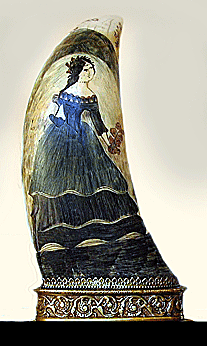 Scrimshaw
is still the most popular piece of whaling history to collect. Today,
it’s highly prized by collectors, who often must pay exorbitant prices
for period pieces. A scrimshaw whale’s tooth from the 1850s, depicting a
mother, father and young child in a landscape, recently sold for $1,440.
And that’s relatively low by today’s pricing standards. Scrimshaw
is still the most popular piece of whaling history to collect. Today,
it’s highly prized by collectors, who often must pay exorbitant prices
for period pieces. A scrimshaw whale’s tooth from the 1850s, depicting a
mother, father and young child in a landscape, recently sold for $1,440.
And that’s relatively low by today’s pricing standards.
Scrimshaw is scrollwork, engravings, and carvings done in bone or ivory.
Typically it refers to the artwork created by whalers, engraved on the
byproducts of whales, such as bones or cartilage. It’s most commonly
made out of the bones and teeth of sperm whales, the baleen of other
whales, and the tusks of walruses. It takes the form of elaborate
engravings in the form of pictures and lettering on the surface of the
bone or tooth, with the engraving highlighted using a pigment, or, less
often, small sculptures made from the same material. However the latter
really fall into the categories of ivory carving, for all carved teeth
and tusks, or bone carving. The making of scrimshaw began on whaling
ships between 1745 and 1759 on the Pacific Ocean, and survived until the
ban on commercial whaling.
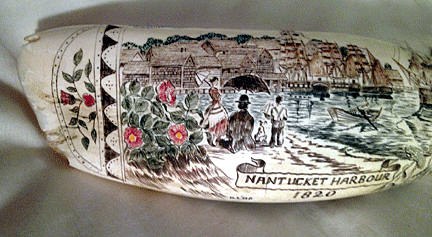 Whale
teeth and bones were a highly variable medium, used to produce both
practical pieces, such as hand tools, toys and kitchen utensils, and
highly decorative pieces, which were purely ornamental. The designs on
the pieces varied greatly as well, though they often had whaling scenes
on them. For example, Herman Melville, in Moby-Dick, refers to "lively
sketches of whales and whaling-scenes, graven by the fishermen
themselves on Sperm Whale-teeth, or ladies' busks wrought out of the
Right Whale-bone, and other skrimshander articles".[5] Most engravings
were adapted from books and papers. Whale
teeth and bones were a highly variable medium, used to produce both
practical pieces, such as hand tools, toys and kitchen utensils, and
highly decorative pieces, which were purely ornamental. The designs on
the pieces varied greatly as well, though they often had whaling scenes
on them. For example, Herman Melville, in Moby-Dick, refers to "lively
sketches of whales and whaling-scenes, graven by the fishermen
themselves on Sperm Whale-teeth, or ladies' busks wrought out of the
Right Whale-bone, and other skrimshander articles".[5] Most engravings
were adapted from books and papers.
Real vs. Fake Scrimshaw
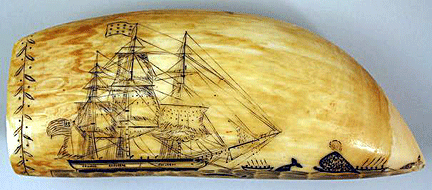 It
can be difficult to tell an original piece of scrimshaw from a forgery.
The easiest way to tell definitively whether a piece is real ivory is by
using the "hot pin test," in which a pin is heated to nearly red hot and
then its tip is touched to an inconspicuous part of the object. If it’s
ivory, it will scorch and smell like burning bone. But if it’s polymer
or plastic, the pin will melt into the piece, and smell like plastic
burning. Also, since ivory is a natural tooth substance that continues
to grow throughout an animal's life, it has noticeable "growth lines"
much like a tree's growth rings. Artificial ivories do not have this
kind of structure and are usually a consistent color throughout. It
can be difficult to tell an original piece of scrimshaw from a forgery.
The easiest way to tell definitively whether a piece is real ivory is by
using the "hot pin test," in which a pin is heated to nearly red hot and
then its tip is touched to an inconspicuous part of the object. If it’s
ivory, it will scorch and smell like burning bone. But if it’s polymer
or plastic, the pin will melt into the piece, and smell like plastic
burning. Also, since ivory is a natural tooth substance that continues
to grow throughout an animal's life, it has noticeable "growth lines"
much like a tree's growth rings. Artificial ivories do not have this
kind of structure and are usually a consistent color throughout.
Another way to tell real ivory scrimshaw from
artificial alternatives is by examining it under a blacklight. The
appearance of genuine scrimshaw will be florescent bright white under
the light.
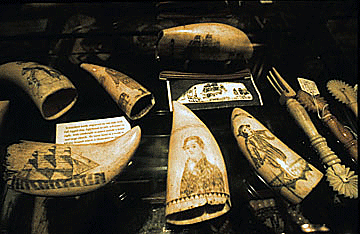 Even
if a scrimshaw piece is ivory, how can a collector determine its age?
Madden noted that when whalemen harvested ivory or bone the surface was
relatively soft and easier to engrave. When it dried out, it becomes
very hard. By taking a strong magnifying glass and checking the natural
wear areas, a collector will find numerous fine scratches. If the piece
is newly incised, a collector will notice the lines often are often
fractured where they cross. This a sure sign of recent work. Also, the
ink and paints in the cracks of the engraved lines in antique pieces
should appear dried out and "crackily." Old debris--dust, dirt,
scratches, etc–also helps decide the age of the a piece. Even
if a scrimshaw piece is ivory, how can a collector determine its age?
Madden noted that when whalemen harvested ivory or bone the surface was
relatively soft and easier to engrave. When it dried out, it becomes
very hard. By taking a strong magnifying glass and checking the natural
wear areas, a collector will find numerous fine scratches. If the piece
is newly incised, a collector will notice the lines often are often
fractured where they cross. This a sure sign of recent work. Also, the
ink and paints in the cracks of the engraved lines in antique pieces
should appear dried out and "crackily." Old debris--dust, dirt,
scratches, etc–also helps decide the age of the a piece.
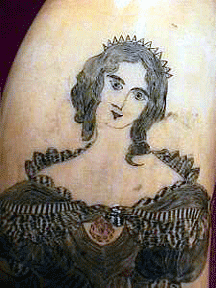 Deciding
if the ivory or bone is old takes a more experienced eye. Upon
examination of the inside of a tooth, a collector should find natural
aging--dirt, spotted stains and a natural aged look. Pieces that have
been artificially aged by staining show a even dark look. Deciding
if the ivory or bone is old takes a more experienced eye. Upon
examination of the inside of a tooth, a collector should find natural
aging--dirt, spotted stains and a natural aged look. Pieces that have
been artificially aged by staining show a even dark look.
The most famous scrimshander was Frederick Myrick of Nantucket, who
produced 35 or more so-called "Susan's Teeth" aboard the Nantucket ship
Susan during 1828-29. As a common seaman in the Nantucket ship Susan
from 1826 to 1829, Myrick incised more than a dozen teeth with portraits
of the Susan and at least three with portraits of other vessels. In each
case the design adheres closely to a single pattern: a broadside
portrait of the ship whaling on the Japan or Peru grounds; another view
of the same vessel homeward bound; identifying labels prominently
featuring the artist's name and, usually, a date, surmounted by an
anchor, American eagle, and crossed flags; and the motto "Death to the
living, long life to the killers/Success to sailors wives & greasy luck
to whalers. He was the first ever to sign and date some of his work
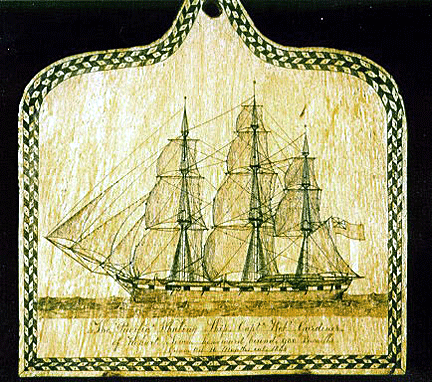 And
scrimshandering wasn’t limited to the whalers, themselves. Wives and
children, who sometimes accompanied whaling captains to sea, also
produced scrimshaw in significant numbers. Some of the women, like
Sallie Smith, wife of Captain Frederick Howland Smith of Dartmouth,
Massachusetts, produced work to as high a standard as their male
counterparts. And
scrimshandering wasn’t limited to the whalers, themselves. Wives and
children, who sometimes accompanied whaling captains to sea, also
produced scrimshaw in significant numbers. Some of the women, like
Sallie Smith, wife of Captain Frederick Howland Smith of Dartmouth,
Massachusetts, produced work to as high a standard as their male
counterparts.
Most period scrimshaw is somewhat crude and very rarely signed or dated.
If a period piece is dated, signed or can be attributed to a specific
scrimshander, that's when the prices start ascending to the ionosphere.
Most serious collectors seek 19th-Century pieces, including a scrimmed
whale’s tooth—the holy grail of antique scrimshaw.
What about Scrimshaw Reproductions?
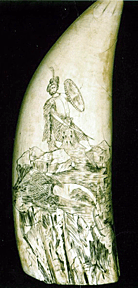 All
kinds of scrimshaw items have been reproduced to sell in whaling museum
shops throughout New England. These sometimes make their way to flea
markets where unsuspecting collectors are often misled into thinking
they are real. “These souvenirs look great,” said Fredrick Mitchell,
owner of the Whalemen’s Shipping List of New Bedford, Massachusetts.
“Today, the weight factor is there besides the density, so it can be
very hard to tell a reproduction by other than an expert. If you find a
tooth at a flea market in some out of the way place, chances are that
it’s a fake. And if it has names on it like New Bedford, Mass., it’s got
all the flags. Scrimshanders rarely dated or signed their work.” All
kinds of scrimshaw items have been reproduced to sell in whaling museum
shops throughout New England. These sometimes make their way to flea
markets where unsuspecting collectors are often misled into thinking
they are real. “These souvenirs look great,” said Fredrick Mitchell,
owner of the Whalemen’s Shipping List of New Bedford, Massachusetts.
“Today, the weight factor is there besides the density, so it can be
very hard to tell a reproduction by other than an expert. If you find a
tooth at a flea market in some out of the way place, chances are that
it’s a fake. And if it has names on it like New Bedford, Mass., it’s got
all the flags. Scrimshanders rarely dated or signed their work.”
And even with old scrimshaw you can tell when you pick it up, even if
you know nothing about the weight or what the tooth should look like
inside. You can feel the difference in the surface. They didn’t have
high polishing machines, and you can feel the coarseness of the file or
see the marks under a magnifying glass.
Because of their desirability and rarity, good busks command a high
price. This, coupled with their relative simplicity makes them common
targets for copies and forgeries, and there are many fakes on the
market.
What to Pay for Scrimshaw
Collectors and dealers are extremely cautious when purchasing antique
scrimshaw. They
look for provenance with which to assure onward buyers of authenticity
and value. Museums generally snap up the more valuable pieces. However,
simple items, such as bodkins, thimbles and winders regularly turn up in
antique shops and shows.
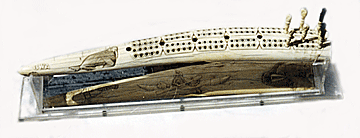
What seemed to be high prices in the1980s are now considered low in
retrospect. Also, there’s a lot more connoisseurship in scrimshaw today.
Scrimshaw whale teeth prices range from $1,200 to $11,000. A signed
Susan’s tooth by Frederick Myrick can fetch over $50.000 at auction.
Some pieces even with a simple design sell for a few hundred dollars.
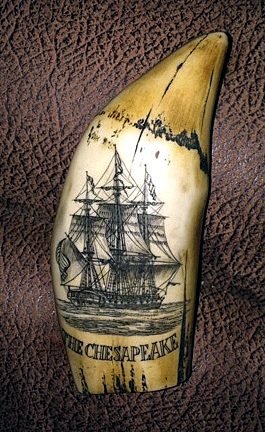 Authentic,
period scrimshaw is definitely getting harder and harder to find.
Genuine pieces are still available if you know where to look and are
willing to pay the price. The days of "great deals" seems to be a thing
of the past. As little as 30 or 40 years ago you used to be able to pick
a whale tooth out of a big old pickle barrel full of them on the wharf
at Nantucket harbor for a buck a-piece! Authentic,
period scrimshaw is definitely getting harder and harder to find.
Genuine pieces are still available if you know where to look and are
willing to pay the price. The days of "great deals" seems to be a thing
of the past. As little as 30 or 40 years ago you used to be able to pick
a whale tooth out of a big old pickle barrel full of them on the wharf
at Nantucket harbor for a buck a-piece!
An 8-inch scrimshaw whale’s tooth by Edward Burdett set a world record
in 2017 when it sold for $456,000. The 1830 piece was engraved “By.
Edward Burdett. Of Nantucket. Onboard Of The Ship Wm Tell. On the
obverse it read: Wm Tell. Of. New York. Cutting. Boiling. & Fast To A
Whale.”
Dealers know just how hot the market is these days for the "real stuff.”
That’s generally reflected in the pricing. But at least you know you're
getting pieces that are "right" if you work with a reputable dealer
experienced specifically in the field of antique scrimshaw. They can do
amazing things with space-age polymers these days, including recreate a
pretty authentic looking & feeling, 150-200 year old scrimmed whale
tooth...so watch out...and as the whalers used to say, ‘Greasy Luck!’”
To read
more of my articles, please
visit
my Web site.
< Back to Antiques Articles
Next Article > |
